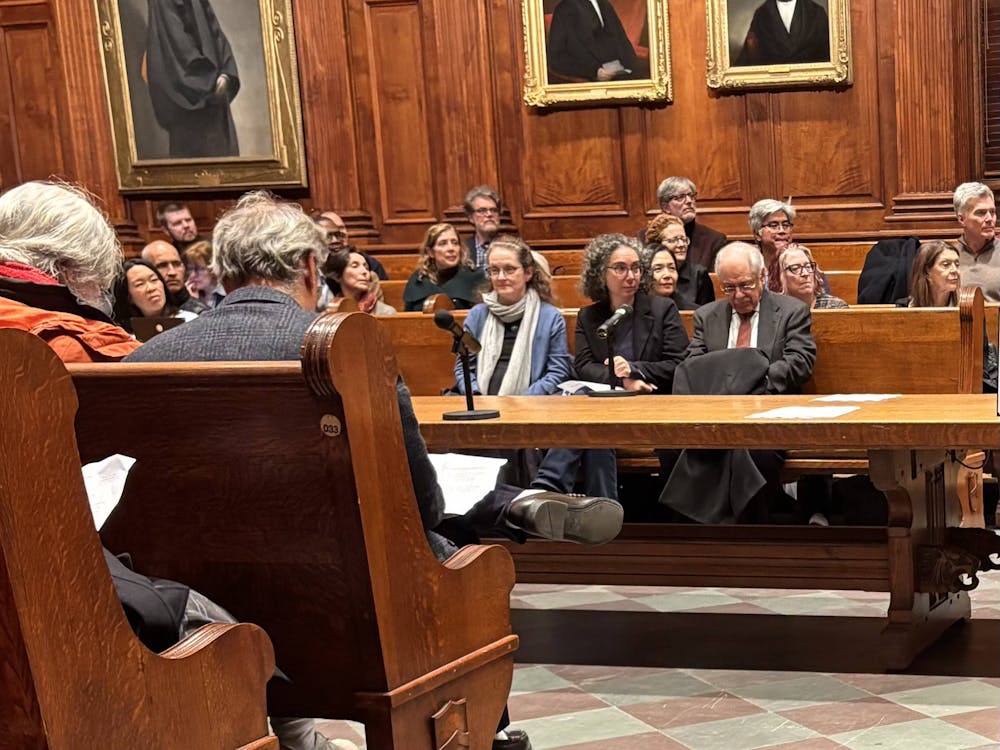Provost Christopher Eisgruber ’83 was confirmed as the 20th University president shortly after noon on Sunday during an extraordinary meeting of the Board of Trustees. The confirmation, reportedly a unanimous vote, came only minutes before Eisgruber was presented to the Board and to the media.
But according to interviews conducted on Sunday afternoon, Eisgruber had actually learned of the committee’s intention to recommend him for the presidency at least a week before the University announcement, when Chair of the Board and of the search committee Katie Hall ’80 had called him and let him know of the decision. At around the same time, Hall had also informed Tilghman but not the Board at large.
Although the Board confirmed the president, it is the search committee alone — made up of nine trustees, one administrator, four faculty members and three students — that made the final recommendation.
“I have to say, you know, I hadn’t heard from her for a bit,” Eisgruber said. “As with any process that you’re going through where you’ve been interviewed and you haven’t heard, you get a bit worried, and so I was exhilarated when I got the call.”
Last Tuesday, Eisgruber had told The Daily Princetonian that he was in St. Louis and that he would not be available for an interview for the rest of the week. In a follow-up email on Thursday, he noted that this was “the craziest time of year” for his schedule.
On Sunday, he explained that he had been presenting a lecture at the time and that being away from campus had also had its benefits.
“It was nice to be out there, and in some ways, it made it a little easier, to be away from campus,” Eisgruber explained. “I didn’t have to dodge questions as much as I would otherwise have to be doing.”
Eisgruber’s appointment came after a seven-month-long process, although his name was circulated widely during those months. As far back as last November, Eisgruber had been speculated by faculty to be one of the strongest contenders for the presidency, along with Wilson School professor and former dean Anne-Marie Slaughter ’80. At the time, Eisgruber wrote in an email to the ‘Prince’ that he did not consider himself a candidate and that he was looking forward to returning to teaching once his time as provost was over.
In the same month, Yale appointed Peter Salovey, who had been the school’s provost for four years, to the position of president only a month after its current president, Richard Levin, announced his retirement. Although Princeton also ultimately selected its own provost, the process took significantly more time.
“We chose the best person for the job, and I believe that the way to discern kind of the truth and the strength of that statement is to do what we did,” Hall explained. “We started with a clean slate; we really did talk to this wide variety of people, sought different viewpoints, different perspectives.”
Hall, the CEO of an asset management company valued at $22 billion, explained that she consulted at least two people outside the committee, although no executive search firm was hired for the process.

“We thought it was one of our primary responsibilities to develop a strong pool of candidates,” Hall noted, explaining that the committee had chosen not to contract a firm to develop the candidates’ list for them.
The committee members also decided against hiring a search firm because they felt they had the capacity to be diligent and received strong logistical support from Vice President and Secretary Bob Durkee ’69, Hall said.
Hall said she consulted Thomas Wright ’62, former University vice president and secretary, and Bob Rawson ’66, chair of the search committee that selected Shirley Tilghman as president in 2001.
“I only was involved in this process at the very beginning just to discuss the processes we followed in the previous [presidential search],” Wright said, adding that he did not receive advance notice of Eisgruber’s selection.
As of press time, Rawson could not be reached for comment.
Hall explained that the full Board of Trustees was not informed of the details of the search process, although she did give regular updates during trustee meetings. Hall declined to comment on whether the search committee had narrowed its candidate field down to solely Eisgruber during a Board of Trustees meeting between April 4–6.
“I shared an update on the process with the Board ... and someone said, you know, can we share the names of other candidates, and I said the same thing I told you, you know, ‘No.’ ”
Wright, who said he was present at a party celebrating Tilghman’s legacy with the trustees that weekend, noted that Eisgruber was also in attendance, although nobody introduced him as the next president or as a potential candidate.
Hall declined to provide many details of the search process, such as the number of candidates interviewed.
“It’s not because we are trying to be lacking transparency,” she said. “An important part of the process is the confidentiality. The strength of that permits the committee members to have completely open and candid conversations.”
Search committee member Robert Murley ’72, who served on the committees that selected both Tilghman and Eisgruber, explained that both processes were essentially the same. The main difference, Murley explained, was that Tilghman was originally a member of the search committee. But, in the end, both had to compete with internal and external candidates for the position.
Staff writer James Evans, associate news editor Marcelo Rochabrun and senior writer Monica Chon contributed reporting for this article.
Click here for all things Eisgruber.







